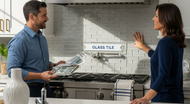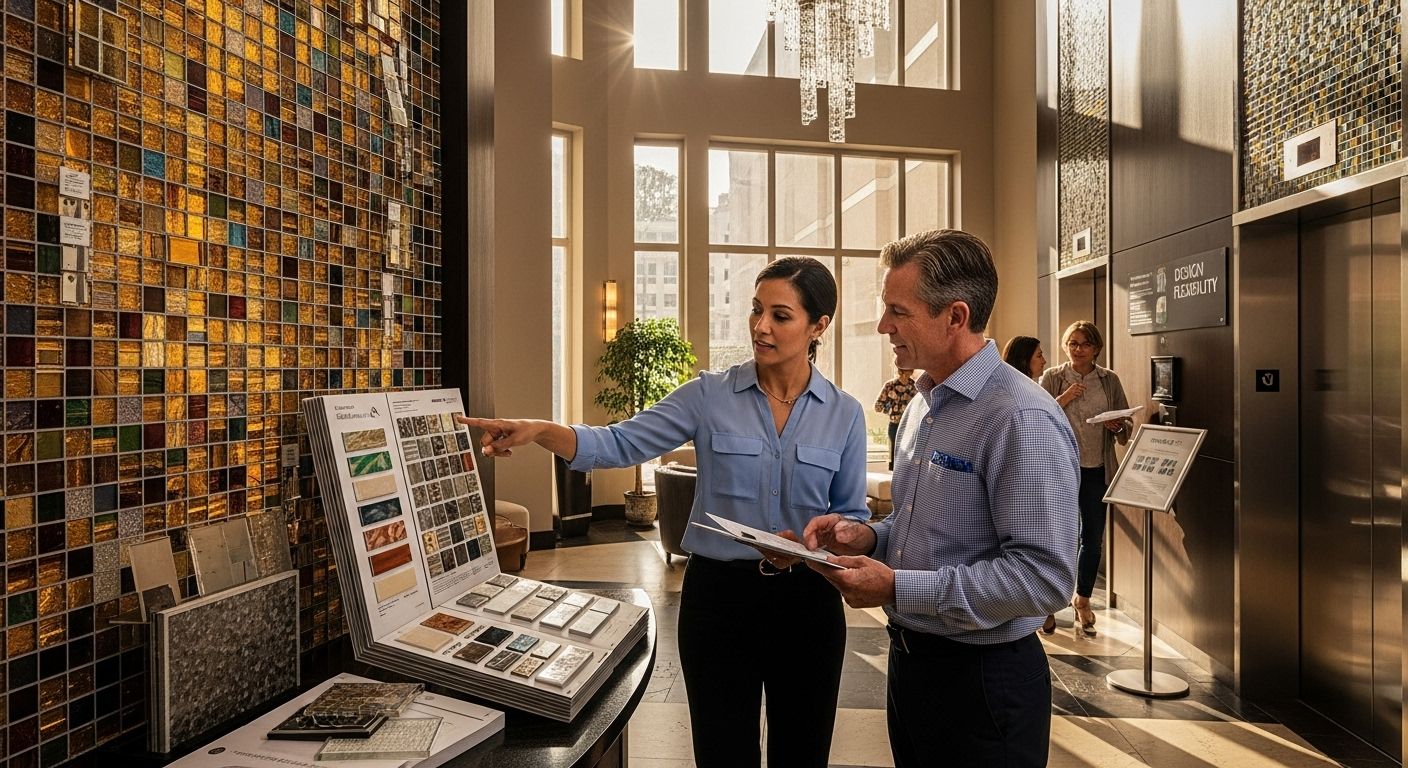What is Glass Tile? Understanding Its Beauty and Benefits
Posted by Mike Belk on Aug 23, 2025

Glass tile turns simple rooms into something extraordinary. Think about this. Modern glass tiles can resist moisture and staining better than traditional ceramics, making them ideal for kitchens and bathrooms. Most people believe glass is fragile and high maintenance. The real surprise is that advanced glass tiles are built so tough and hygienic they outlast and outperform many classic materials.
Table of Contents
- The Nature Of Glass Tile: Composition And Characteristics
- Why Glass Tile Matters: Aesthetic And Functional Benefits
- How Glass Tile Works: Applications In Design And Decor
- Understanding The Varieties Of Glass Tile: Types And Textures
- Real-World Context: Glass Tile In Homes And Commercial Spaces
Quick Summary
| Takeaway | Explanation |
|---|---|
| Glass tile combines aesthetic and engineering excellence | It merges artistic design with advanced material properties for unique surfaces. |
| Versatile design options enhance creative expression | Infinite color variations and textures enable personalized design solutions in various spaces. |
| Non-porous surface offers practical advantages | Resistant to moisture, stains, and bacteria, making it ideal for kitchens and bathrooms. |
| Durability ensures longevity in high-traffic areas | Modern manufacturing techniques enhance glass tile’s structural integrity for demanding environments. |
| Transforms spaces with visual depth and light manipulation | Glass tiles can create illusions of space, enhancing the ambiance and appeal of any environment. |
The Nature of Glass Tile: Composition and Characteristics
Glass tile represents a remarkable fusion of artistic design and advanced material engineering, transforming how we perceive surface treatments in architectural and decorative spaces. At its core, glass tile is a manufactured product created through a sophisticated process of melting, molding, and cooling specialized glass materials to produce durable, aesthetically pleasing surface coverings.
Material Composition and Manufacturing
The fundamental composition of glass tile involves silica sand, soda ash, and limestone, which are carefully heated to extremely high temperatures and then transformed into precise tile formations. Discover the intricate process behind tile creation reveals the meticulous craftsmanship involved in producing these remarkable surfaces.
Key characteristics of glass tile composition include:
- Transparency and light-reflective properties
- Non-porous surface structure
- Resistance to moisture and staining
- Uniform color distribution
Unique Physical Properties
Unlike traditional ceramic or stone tiles, glass tiles offer extraordinary performance characteristics. Their non-absorbent nature makes them exceptionally hygienic and easy to clean, preventing bacterial growth and maintaining a pristine appearance. The manufacturing process allows for incredible design versatility, enabling creators to produce tiles with complex color gradients, embedded patterns, and multiple translucency levels.
The physical durability of glass tiles stems from their molecular structure, which provides remarkable strength despite appearing delicate. Modern glass tiles undergo rigorous tempering processes that enhance their structural integrity, making them suitable for high-traffic areas and demanding environmental conditions.
By understanding the intricate nature of glass tiles, homeowners and designers can appreciate not just their aesthetic appeal, but also the sophisticated engineering that transforms simple raw materials into stunning architectural elements.

Why Glass Tile Matters: Aesthetic and Functional Benefits
Glass tile transcends traditional surface covering expectations, offering a sophisticated blend of visual elegance and remarkable performance characteristics that revolutionize interior design and architectural spaces. Its unique combination of aesthetic versatility and practical functionality makes it a compelling choice for discerning homeowners and design professionals.
Visual Sophistication and Design Flexibility
The aesthetic potential of glass tile is virtually limitless. Explore innovative design possibilities with glass mosaic tiles reveals how these materials can transform ordinary spaces into extraordinary environments. Glass tiles provide designers and homeowners with unparalleled creative freedom through:
- Infinite color variations and translucency levels
- Ability to create complex visual patterns and gradients
- Light-reflective qualities that enhance spatial perception
- Seamless integration with multiple design styles
Performance and Practical Advantages
Beyond their stunning visual appeal, glass tiles offer substantial functional benefits that distinguish them from traditional surface materials. Their non-porous surface creates a hygienic environment resistant to moisture, bacterial growth, and staining. This makes glass tiles particularly advantageous in high-humidity areas like bathrooms and kitchens.
The durability of modern glass tiles stems from advanced manufacturing techniques that enhance their structural integrity. Tempered and treated glass tiles can withstand significant environmental stress, maintaining their aesthetic quality over extended periods. Their smooth surface facilitates effortless cleaning, requiring minimal maintenance while preserving their original brilliance.
Ultimately, glass tiles represent more than just a surface covering. They are a sophisticated design solution that harmonizes aesthetic beauty with exceptional functionality, enabling transformative spatial experiences that elevate both residential and commercial environments.
How Glass Tile Works: Applications in Design and Decor
Glass tile represents a sophisticated design solution that seamlessly integrates artistic expression with functional innovation across diverse architectural environments. Its versatility enables designers and homeowners to reimagine spaces through dynamic visual transformations and strategic surface treatments.
Architectural and Interior Design Integration
Explore advanced design strategies for glass tile applications unveils the nuanced ways these materials can dramatically enhance interior landscapes. Glass tiles function as more than mere surface coverings, acting as transformative design elements that can:
- Create visual depth and spatial complexity
- Introduce luminous color gradients
- Manipulate light and reflection
- Define architectural zones and boundaries
Practical Implementation and Design Strategies
The strategic application of glass tiles extends across multiple design contexts, from residential kitchens and bathrooms to commercial and hospitality environments. Their ability to reflect light and create visual intrigue makes them particularly effective in spaces requiring visual expansion or atmospheric enhancement.
Architectural designers leverage glass tiles as powerful design tools, using them to craft feature walls, backsplashes, accent areas, and even entire surface treatments. The translucent and reflective properties allow for sophisticated visual layering, enabling designers to create immersive spatial experiences that transcend traditional surface treatments.
By understanding the technical and aesthetic capabilities of glass tiles, design professionals can unlock innovative approaches to environmental transformation, turning ordinary spaces into extraordinary visual narratives that engage and inspire.
Understanding the Varieties of Glass Tile: Types and Textures
Glass tile represents a dynamic design medium with an extraordinary range of styles, textures, and visual characteristics that cater to diverse aesthetic preferences and functional requirements. The complexity and sophistication of glass tile varieties enable designers and homeowners to create truly personalized spatial experiences.
Texture and Surface Complexity
Discover the intricate world of tile surface designs illuminates the nuanced approaches to glass tile texture. Glass tiles are not uniform surfaces but rather sophisticated design elements that can be engineered with remarkable textural variations:
- Smooth and polished surfaces that reflect light
- Textured and embossed finishes creating dimensional depth
- Frosted and matte treatments reducing glare
- Handcrafted surfaces with intentional irregularities
Classification and Design Variations
Glass tiles encompass multiple subcategories, each offering unique visual and functional characteristics. Translucent glass tiles allow light transmission, creating ethereal visual effects, while opaque variants provide solid color coverage. Recycled glass tiles represent an environmentally conscious option, transforming post-consumer glass materials into stunning architectural surfaces.
Architectural glass tiles range from uniform grid patterns to complex mosaic configurations, enabling designers to craft intricate visual narratives. The manufacturing process allows for unprecedented color saturation, gradient effects, and embedded design elements that transform ordinary surfaces into extraordinary visual experiences.
By understanding the diverse landscape of glass tile varieties, design professionals can select precisely the right material to achieve their specific aesthetic and functional objectives, turning architectural visions into tangible, breathtaking realities.
To better visualize the range of glass tile varieties and finishes available to designers and homeowners, the table below organizes common types, textures, and their main visual effects.
| Glass Tile Type | Texture/Finish | Visual Effect/Benefit |
|---|---|---|
| Smooth & Polished | Glossy | Maximizes light reflection, sleek look |
| Textured/Embossed | Raised or patterned | Adds dimensional depth and visual interest |
| Frosted/Matte | Subdued, non-reflective | Reduces glare, softens appearance |
| Handcrafted | Irregular/Artisanal | Unique, custom design elements |
| Translucent | Semi-transparent | Allows light to pass through, ethereal feel |
| Opaque | Solid color | Bold statement, color focus |
| Recycled Glass | Varies | Eco-friendly, unique color combinations |
Real-World Context: Glass Tile in Homes and Commercial Spaces
Glass tile has emerged as a transformative design solution, bridging aesthetic sophistication with practical functionality across residential and commercial environments. Its versatility enables architects and designers to create spaces that are simultaneously visually striking and highly performative.
Residential Design Applications
Discover innovative ways to enhance home aesthetics reveals the remarkable potential of glass tiles in residential settings. Homeowners increasingly utilize glass tiles in high-impact areas such as:
- Kitchen backsplashes creating luminous focal points
- Bathroom accent walls adding visual depth
- Shower enclosures with sophisticated design elements
- Fireplace surrounds introducing elegant texture
Commercial and Architectural Implementations
In commercial environments, glass tiles transcend decorative purposes, serving critical functional and aesthetic roles. Hospitality spaces, corporate offices, healthcare facilities, and public buildings leverage glass tiles to create environments that are both visually compelling and strategically designed.
Architectural applications range from expansive feature walls in corporate lobbies to intricate mosaic installations in museums and galleries. The material’s ability to manipulate light, create visual depth, and maintain hygienic surfaces makes it an ideal choice for spaces requiring both aesthetic refinement and practical performance.
By understanding the nuanced applications of glass tile, design professionals can transform ordinary spaces into extraordinary environments that inspire, engage, and elevate human experiences across diverse architectural contexts.

Experience the Lasting Beauty and Benefits of Glass Tile with BELK Tile
If you are captivated by the unique transparency, durability, and hygienic properties of glass tile described in the article, you have likely faced the challenge of finding tile solutions that offer both stunning visual impact and easy-to-maintain surfaces. Many homeowners and designers struggle to locate options that combine modern style with true versatility for spaces like kitchens, bathrooms, and commercial settings. At BELK Tile, our collection reflects exactly what you learned in the article: vibrant color choices, advanced manufacturing, and textures that enhance both function and design.
Discover how our range of glass mosaic tiles easily brings your design vision to life while solving problems like stains, water resistance, and lack of creative freedom. Whether you need a new backsplash, a bathroom update, or a feature wall, BELK Tile offers the quality and inspiration you are seeking. Do not wait to transform ordinary surfaces into extraordinary statements. Visit BELK Tile’s website to explore our full selection and start your next project with confidence today.
Frequently Asked Questions
What are the main benefits of using glass tile in interior design?
Glass tile offers a blend of aesthetic elegance and functional durability. Its non-porous surface resists moisture and stains, making it easy to clean and hygienic. Additionally, the light-reflective properties enhance the perception of space and allow for creative design versatility.
How does glass tile compare to traditional ceramic tiles in terms of maintenance?
Glass tile requires less maintenance than traditional ceramic tiles due to its non-porous nature, which prevents the accumulation of dirt and bacteria. Cleaning is typically effortless, as a simple wipe-down with a damp cloth is often sufficient to maintain its brilliance.
To help clarify the main differences between glass tile and traditional ceramic tile as discussed in the article, the following table summarizes their key characteristics and maintenance aspects.
| Feature | Glass Tile | Traditional Ceramic Tile |
|---|---|---|
| Moisture Resistance | Excellent (Non-porous) | Good, but can be slightly porous |
| Stain Resistance | Superior (Resists stains effectively) | Good, but grout can stain |
| Maintenance | Easy (simple wipe-down; hygienic) | Moderate (may require scrubbing/grout care) |
| Design Versatility | Infinite colors, gradients, translucency levels | Wide variety, but less light-reflective |
| Durability | Highly durable (especially modern versions) | Durable but can chip or crack |
| Hygienic Properties | Resists bacterial growth | Can foster bacteria in grout lines |
| Light Manipulation | Reflects and transmits light, brightening space | Absorbs more light |
Can glass tiles be used in high-humidity areas like bathrooms?
Yes, glass tiles are an excellent choice for high-humidity areas such as bathrooms. Their non-porous surface prevents moisture absorption, making them resistant to mold and mildew, thus ensuring a healthier environment.
What types of textures and finishes are available for glass tiles?
Glass tiles come in a variety of textures and finishes, including smooth and polished surfaces, textured or embossed finishes, frosted or matte treatments, and handcrafted designs. These variations allow for creative design possibilities that can enhance the overall aesthetic of a space.



